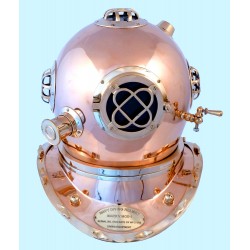No products
Nautical Decor & Brass Gifts
New products
-

Amedeo Modigliani, Seated Nude, 1918, 34 mm solid Brass Tank Watch
33 mm solid brass casing with stainless steel back premium 2040 quartz...
$ 142.63 -

Tintin Professor Calculus Savate! Solid Brass Large 40 mm Gold finition
a very interesting handmade artisanale graphic art collectible wrist...
$ 158.11 -

Return of President Donald Trump. Make America Great Again Wrist Watch. Classic Americana!
Large Format Gents Stainless Steel Wrist Watch with Premium Quartz...
$ 145.89 -

Casino Roulette Wheel Monte Carlo Original Gambling Art Shiny Metallic Dial Solid Brass 40 mm Watch
40 mm large format solid brass casing with stainless steel back....
$ 137.74 -

Proud To Be An Eagle Scout, High Quality Solid Brass Boy Scouts 40 mm Wrist Watch
40 mm solid brass casing with stainless steel back premium 2040 quartz...
$ 137.74
Full-size US Navy Retro Diving Helmet Diver's Copper & Brass Casque. 18-inch (45 cm)
NAU-030
New product
18 INCHES HIGH (45 cm), 9.50 kilos of solid brass and copper
More info
Diving helmets are worn mainly by professional divers engaged in surface supplied diving, though many models can be adapted for use with scuba equipment.
The helmet seals the whole of the diver's head from the water, allows the diver to see clearly underwater, provides the diver with breathing gas, protects the diver's head when doing heavy or dangerous work, and usually provides voice communications with the surface (and possibly other divers). If a helmeted diver becomes unconscious but is still breathing, the helmet will remain in place and continue to deliver breathing gas until the diver can be rescued. In contrast, the scuba regulator typically used by recreational divers must be held in the mouth, otherwise it can fall out of an unconscious diver's mouth and result in drowning[2] (this does not apply to a full face mask which also continues to serve air if the diver is unconscious).
Before the invention of the demand regulator, all diving helmets used a free-flow design. Gas was delivered at a constant rate, regardless of the diver's breathing, and flowed out through an exhaust valve. Most modern helmets incorporate a demand valve so the helmet only delivers breathing gas when the diver inhales. Free-flow helmets use much larger quantities of gas than demand helmets, which can cause logistical difficulties and is very expensive when special breathing gases (such as heliox) are used. They also produce a constant noise inside the helmet, which can cause communication difficulties. Free-flow helmets are still preferred for hazardous materials diving, because their positive-pressure nature can prevent the ingress of hazardous material in case the integrity of the suit or helmet is compromised. They also remain relatively common in shallow-water air diving, where gas consumption is of little concern, and in nuclear diving because they must be disposed of after some period of use due to irradiation; free-flow helmets are significantly less expensive[citation needed] to purchase and maintain than demand types.
Most modern helmet designs are sealed at the neck using a neoprene "neck dam" which is independent of the suit, allowing the diver his choice of suits depending on the dive conditions. When a neck dam is installed into a drysuit, however, the entire body is isolated from the surrounding liquid, giving an additional degree of warmth and protection. When divers must work in hazardous environments such as sewage or dangerous chemicals, a helmet (usually of the free-flow type or using a series exhaust valve system) is sealed to a special drysuit (commonly made of a fabric with a smooth vulcanised rubber outer surface) to completely isolate and protect the diver. This equipment is the modern equivalent of the historic Mark V "Standard Diving Dress".
Standard diving helmet (Copper hat)
Historically, deep sea diving helmets ranged from the no bolt to two bolt to four bolt helmets; helmets with six, eight, or 12 bolts; and Two-Three, Twelve-Four, and Twelve-Six bolt helmets. Bolts being the method of securing the helmet to the diving suit. The helmet could also be secured to the breastplate (corselet) by bolts as in the case of US twelve-four helmets (12 bolts to the suit, four bolts seal helmet to corselet). The no bolt helmet used a spring-loaded clamp to secure the helmet to corselet over the suit. Swedish helmets were distinctive for using a neck ring instead of a corselet, a pioneer of modern diving equipment but hugely cumbersome and uncomfortable for the diver. This equipment is commonly referred to as "heavy gear."
Reviews
No customer reviews for the moment.




